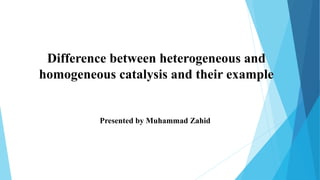
Presentation1 catalysis
- 1. Difference between heterogeneous and homogeneous catalysis and their example Presented by Muhammad Zahid
- 2. What is the catalyst? “The definition of a catalyst, as reported by the International union of Pure and Applied Chemistry (IUPAC), states that it is a material which rise the velocity of a reaction not altering the total standard Gibbs energy change in the reaction”.
- 3. Homogeneous catalysis: A catalytic system in which the substrates for a reaction and the catalyst components are brought together in one phase, most often the liquid phase. Homogeneous catalysts are the simple molecules or ions such as HF, H2SO4, Mn+2 as well as complex molecules such as organometallic complexes, macrocyclic compounds and large enzyme molecules. The oldest homogeneous catalysts are metallo-enzyame. A very old catalytic process is the making of sulfuric acid called lead chamber process (1750) in which nitrogen oxides oxidise to the trioxide and NO is re-oxidize by air to NO2. Some other example of such catalyst are: general acid and base catalysis (ester hydrolysis) Lewis acids catalyst (diels-alder reaction) Organic catalysts (thiazlium ions in cannizzarro reaction) Porphyrin complexes (epoxidation, hydroxylations)- iron phorphyrin active for oxidation. Enzymatic processes Co-ordination complexes (polyester condensation) Zinc complex for decarboxlation reaction and alcohol dehydrogenase Nickel complexes in hydrogenase enzymes for hydrogen activation
- 4. Heterogeneous catalysis A catalytic system in which the catalyst and the reactant are in different phases. They may exist in liquid, solid and gas phase. Heterogeneous catalysis was introduced by Berzelius and Mitscherlich who determined that the reactions could be fastened by solids. The term contact Catalysis was introduced at that time. The first heterogeneous catalytic reaction, i.e. ethanol dehydration in active clay, was studied by Priestley in 1778; later Van-Marum in 1796, was the first to use metallic catalysts for the dehydrogenation of ethanol, Later in 1823 ammonia is decompose into nitrogen and hydrogen gas when it was passed over burning metals. “The true revolution in industrial catalysis occurred in 1918 when Haber synthesized ammonia from the nitrogen in air and hydrogen”. The whole heterogeneous catalytic process, where the reactant and products are fluids proceed, in general, through the following steps. Diffusion of the reactant molecule or molecules to the solid catalyst Adsorption of at least one of the reactants Chemical reaction between the molecules adsorbed on neighboring locations Desorption of products Diffusion of products into the bulk of the fluid phase
- 5. General difference between homogeneous and heterogeneous catalyst Homogenous catalysis is often pH dependent (and sometimes less efficient and less environmentally-friendly than heterogenous catalysis. Phase: Homogeneous: Liquid when reactant are in gas form. Heterogeneous; Liquid, gas, solid Operative temperature: Homogenous: Usually low temperature Heterogeneous: High temperature- limitation on stability of catalyst Diffusivity: Homogenous: High diffusivity because of having all reactants and catalyst in same phase Heterogeneous: Diffusivity may be less for catalyst with low surface area
- 6. Heat transfer: Homogeneous: High heat transfer due to same phase of all reactants and catalyst. Heterogeneous: Heat transfer might be an issue due to the different heat capacities of reactant and catalyst Catalyst separation: Homogeneous: The separation of product from catalyst may be difficult and expensive. Heterogeneous: can easily separate the product. Recycling: Homogeneous: recycling is expensive due to the difficult treatment of catalyst. Heterogeneous: Recycling is easy and low cost as compare to homogeneous, some reactivating treatment is required. Heat transfer: Homogeneous: High heat transfer due to same phase of all reactants and catalyst. Heterogeneous: Heat transfer might be an issue due to the different heat capacities of reactant and catalyst Catalyst separation: Homogeneous: The separation of product from catalyst may be difficult and expensive. Heterogeneous: can easily separate the product. Recycling: Homogeneous: recycling is expensive due to the difficult treatment of sent catalyst. Heterogeneous: Recycling is easy and low cost as compare to homogeneous, some reactivating treatment is required.
- 7. Catalyst Modification: Homogeneous: Relatively easy. Tuning of the electronic and steric properties on the metal can be done by varying donor atoms in the ligands or by tuning the donating abilities of the ligands. For example, if triphenylphosphine is the ligand and one needs to have a less donating phosphine, the phenyl groups on the phosphine could be tuned (adding CF3, F, and other electron withdrawing groups. Heterogeneous: Modification is difficult relative to homogeneous. At molecular level it is extremely difficult while controlling the particle size and of the active site. There are few synthetic methods are available. Reaction mechanism: Homogeneous: Reaction mechanism can easily find relatively, because direct methods are available (they look at catalyst and not at the products of the reaction). Infrared spectroscopy, Single crystal X-ray diffraction, Liquid state NMR: Heterogeneous: Difficult to find out. Mainly by indirect methods (they look at products and not at the catalyst itself). Liquid State NMR, Electron microscopy, X-ray absorption
- 8. Example of Homogenous catalysis: Types of reactions Several homogeneous catalytic systems are: 1. Acid base catalysis 2. Catalysis by metal ions 3. Catalysis by organometallic complexes 4. Catalysis by Lewis acids 5. Catalysis by porphyrin complexes 6. Catalysis by enzymes Acid catalyzed condensation: Acid catalyzed dehydration of ethyl alcohol to ethylene Catalysis by Metal ion: Cobalt complex catalysts:
- 9. Example of Heterogeneous catalysis:
- 10. Hydrogenolysis of benzyl derivatives: Haber process: Hydrogenation of alkene and cyclohexene: Selective Oxidation of Hydroxymethylimidazoles to Formylimidazole Automotive exhaust catalysis:
